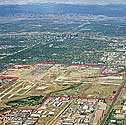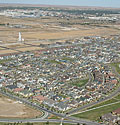An Abandoned Airport Brownfield Takes Off
Tom Gleason, with Forest City Stapleton, said the redevelopment reflects the will of Denver's citizens. "What we're trying to do is to implement a vision for how we reflect the surrounding neighborhood," Gleason said. The Stapleton Design Book, developed by Wolff Lyon Architects of Boulder for Forest City Stapleton, lays out zoning requirements and architectural styles for home developers working at Stapleton, all of which is organized within a master plan developed by several contributors, including Cooper, Robertson and Partners; Calthorpe Associates; and EDAW.
Further building off sustainable principles of the Stapleton Development Plan, Forest City Stapleton produced its own sustainability master plan emphasizing connectivity between zoning districts, community education, residential construction requirements for builders to meet the Environmental Protection Agency's Energy Star and the evolving LEED residential efficiency benchmarks, the institution of recycling programs, and various alternative transportation initiatives. Gleason said all of these programs add up to houses that are 30 percent more efficient than the typical home built within existing codes. And while Gleason notes home sales are so good they have had to instigate a lottery process, buyers still must legally sign an agreement that they are aware of the previous environmental conditions of the land under their homes.
Land values, developer interest rise
Thus, the embedded environmental history of Stapleton is always already present in every aspect of its redevelopment, from the impetus to begin the plan in the 1980s to the legal documents involved in every new real estate transaction. It has certainly not deterred home buyers, including the City of Denver's brownfields coordinator, Stacey Eriksen, who considered the contamination minor. "As a homeowner, I wasn't concerned at all," Eriksen said. "I wanted to be closer to the city, it's less expensive, and I'm a block from an 80-acre park."
While redevelopment in many American inner cities has lately focused on industrial or commercial building conversions to residential use, a low-rise residential development of the scale of Stapleton is a rare opportunity. And while the economic benefits-30,000 new residents, 35,000 new jobs, and 1,116 acres of park and open space, representing a $5 billion investment in the city over 25 years-of such a development are clear, brownfield redevelopment projects nationwide are only now beginning to make more economic sense for developers.
Robert Colangelo, executive director of the National Brownfield Association, said owners and developers are beginning to look at brownfields again because of rising land values in inner cities, which is why he encourages developers to involve their architects and other design consultants in the process as early as possible so that design solutions for brownfield remediation, as well as for the project, can be considered holistically. Colangelo also cites the institution of voluntary cleanup programs at the state level as making it easier to remediate contamination without onerous oversight. "In general, what's changed is the liability relief from state programs," Colangelo said, referring to the use of No Further Action (NFA) letters from state agencies that mostly clear developers of responsibility for environmental contamination associated with a brownfield once they have cleaned it up.
Colorado's state legislature passed the Voluntary Cleanup and Redevelopment Act in 1994. Colorado, as elsewhere, provides an income tax credit of up to $100,000 to compensate landowners for remediation costs; the state also runs loan and redevelopment credit programs. The Colorado Department of Public Health and Environment administers the voluntary cleanup program. The Environmental Protection Agency's Web site (www.epa.gov/swerosps/bf/) provides a complete resource for tracking down information for anyone pursuing brownfield remediation.
Â












